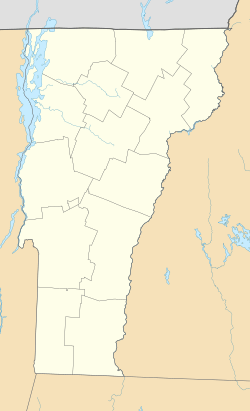Danby Village Historic District facts for kids
Quick facts for kids |
|
|
Danby Village Historic District
|
|

Main Street
|
|
| Location | Main St., Mt. Tabor Ave., Depot St., and Borough Hill Rd., Danby, Vermont |
|---|---|
| Area | 40 acres (16 ha) |
| Built | 1800 |
| Architectural style | Greek Revival |
| NRHP reference No. | 83003219 |
| Added to NRHP | February 10, 1983 |
The Danby Village Historic District is a special area in the heart of Danby, Vermont. It covers a big part of the town center. This historic district is mainly found along Main Street, between Depot Street and Brook Road.
The village has many buildings from the mid-1800s. Most of these are homes, but there are some newer buildings too. This important area was added to the National Register of Historic Places in 1983.
Contents
What Makes Danby Village Special?
The town of Danby is located in southeastern Rutland County, Vermont. People first settled here in the late 1700s. The area that is now Danby Village started around 1800.
At first, Danby Village was not as important as another area called Danby Corners. But it was home to some of the town's first mills. The economy here was mostly about farming.
How Marble Changed Danby
Danby Village became much more important starting in the 1840s. This was when marble quarrying became the town's main industry. Marble is a beautiful stone used for building.
Because of the marble industry, many buildings in the village have marble foundations. Most of these buildings were built in the popular Greek Revival style. This style was common at the time. Only one building in the district is made completely out of marble.
The Railroad Arrives
The village grew even more when the railroad came in 1851. The railroad made it easier to transport goods and people. This helped Danby Village become the main economic and civic center of the town. It soon became more important than Danby Four Corners.
What Kinds of Buildings Are There?
The Danby Village Historic District is mostly around the spot where Main Street meets Mount Tabor Avenue. It stretches south past Depot Street and north almost to Creamery Brook Road.
There are 83 buildings in this district. Most of them are very old and important to history.
Architectural Styles You'll See
Most of the buildings are in the Greek Revival style. This style often features columns and simple, grand designs. However, some of the larger buildings show off later styles. These include the Italianate and Queen Anne styles, which are often more fancy.
There are also a few homes built in the early 1900s. Important public buildings in the district include the town library and the fire station. There are also two churches. The oldest church was built around 1838. It is a Congregational church with early Gothic features.



